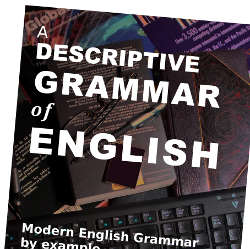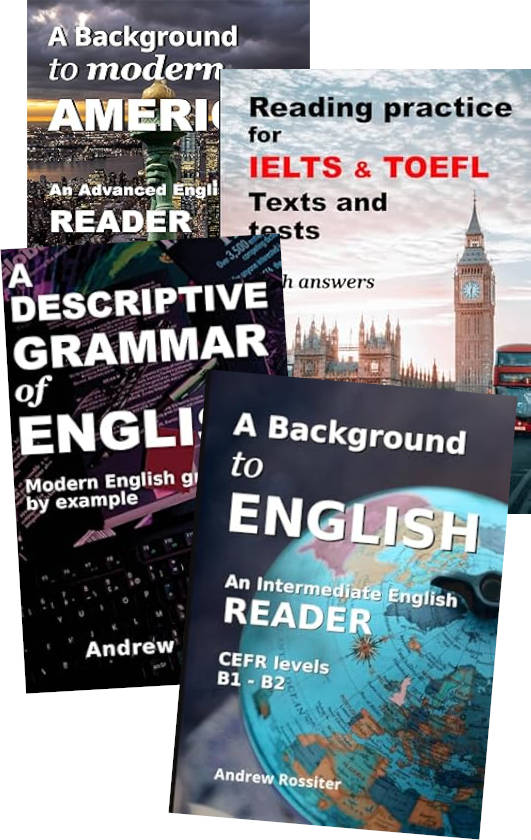

The thirty essential terms of grammar
A glossary of keywords for explaining grammar
by Andrew RossiterEnglish grammar and linguistics have been the subject of much research over the past fifty years; but as some of those most deeply involved in this research admit, the results have been underwhelming where the teaching of English grammar is concerned.
One of the many difficulties faced by teachers is the inconsistency in terminology, as Bas Aarts, professor at UCL and author of many books on English grammar, has pointed out.
This glossary has been drawn up in the belief that much of the confusion is due not so much to inconsistencies, but to poor and cumbersome explanations of English grammar terms, even from the experts, and to a proliferation in grammar resources of technical jargon that does little to make things clearer, and lots to make them seem more complicated.
Here therefore is a list of just thirty keywords – each once explained as simply and briefly as possible, and illustrated with a relevant example. These short definitions will allow teachers to explain most of the fundamentals of English grammar in a language that others can understand.
These descriptions are deliberately brief, so that they are easier to explain and remember.
Clearly this page does not provide a complete glossary of grammar; nor does it go into all the details and exceptions relating to each headword. That is not its aim.
For those who want more detail, more examples, but not jargon, all of the terms and points listed below, as well as other terms mentioned but not included in the 30 keyword list, are clearly explained in A Descriptive Grammar of English (paperback, hardback or ebook)
Group 1 – Six units of meaning, from the smallest to the biggest.
Morpheme - a morpheme is the smallest unit of meaning in language. A word may be made up of a single morpheme, for example child / speak / good / please or a combination of morphemes, for example speaker / goodness / pleased.
Word - a word is the smallest complete free-standing unit of meaning in a language.
Phrase - A
phrase is a group of words which
form a
single unit
of meaning, but is not a clause.
The
man in the red shirt
is a phrase, but so is
the
red
shirt on its own.
Clause - A clause is a group of words that has intrinsic meaning, since it contains a subject and a verb.
Sentence
- A sentence is the basic unit that constitutes a
declarative or
interrogative statement.
Almost
all sentences have at least two words, including a subject
and a
verb.
Paragraph - Paragraphs are the principal sub-divisions of documents.
Group 2. Twenty-four other key grammatical terms (A-Z)
Active: –
Example
The
students
were
studying
English.
The
active
"voice" is
the main voice in
which verbs are used. The
other voice is the passive.
In
the
active voice,
the subject
is
the doer or
the topic of
the action
expressed by means of the verb.
Adjective –
Examples: Good
/ bad /
ugly / disreputable.
An adjective
is a
word that describes or modifies a noun,
or
occasionally a
pronoun.
Key
words
used in relation
to
adjectives: attributive,
predicative,
comparative, superlative.
Adverb
- Examples: Well
/ badly / sometimes
/ quite
/ on the table .
An
adverb is a word or
a prepositional phrase that
describes or modifies a verb,
an adjective, another
adverb, or
occasionally a whole sentence.
Article
- Examples: A
/ an / the
An article is a type of determiner which comes before a noun. In English there are two sorts of articles, the definite article the, and the indefinite articles a and an. Some grammar sources also consider the word some as an indefinite article.
Auxiliary –
Examples:
am
/ is / was / has/ have / must / can / ought
to
Auxiliaries
are "helper" verbs which are used to form tenses
or modify the meaning of a verb
with regard to
time,
possibility, suitability or obligation.
Key
words used in relation to
auxiliaries: modal.
Conjunction
– Examples: and
/ but / or / yet / though
A
conjunction is a connector
or connecting word, a
word that is
used to link sentences, clauses, phrases
or words.
Determiner:
Examples:
the
/ a/ some / my / his / this / whose / Mary's /
ten
Determiners
are used at the start of a noun
phrase.
They include
articles, demonstratives,
numerals, or possessive
determiners. All
nouns or noun phrases
require a determiner unless they are used as
generalisations.
Endings :
Examples:
-ing / -ed / -ly / -ness / -ity
/ - ual
Also
called suffixes,
endings are grammatical or functional morphemes
that are added to the end of word to inflect or change its meaning.
Compared to many languages, English has relatively few endings.
Intensifier :
Examples:
very
/ extremely / most / highly
A
type of adverb
of degree that is used to give extra force to the meaning
of an adjective or
another adverb.
Modal verb:
Examples:
must / will / ought to / should
/
These
are helper
verbs,
or auxiliaries,
such as can
or must that
are most commonly coupled
to another verb in order
to express
possibility, obligation, probability or futurity.
Mood: In English there are three "moods", the indicative, the subjunctive and the imperative. Most of the time verbs are used in the indicative; the imperative is used for giving orders; the subjunctive is very rarely used.
Noun – Examples:
Man
/ woman /
chair / basket / birth
/ oxygen
/ philosophy / Christopher / idea
A
noun is a word that
describes an entity
(person, item, substance
etc.) or a process.
It is usually preceded by a determiner
(article or other determiner) and may be qualified or modified by one
or more adjectives,
by
prepositional phrases, or by another noun.
Key
words
used in
relation to
nouns:
countable,
uncountable, concrete, abstract, collective.
Object – Example:
I
gave a book to my mother.
There
are two kinds of object,
the direct
object and the indirect
object. In the example, a book
is the direct object, to
my mother
is the indirect object.
The direct object is
the
entity (person, thing, process) that is directly concerned by the
action expressed through a transitive verb,
or is
the entity
that explains the action or process. The indirect object
is the person or entity that is the receiver of the action, or for
whom the action is done.
Passive –
Example:
The tree was
blown over by
the wind.
The
passive is a "voice".
A
passive
sentence is one in which the subject
is the topic of the action (in
this example tree),
not the actor or agent (in
this example
wind).
Verbs are either
used in
the
passive or in the active
voice.
Predicate
–
Example:
(We)
had chicken and chips for lunch at school today.
Everything
in a sentence that is not the subject.
The
predicate includes
the verb,
or verbs, plus any other elements that may be present,
notably objects
or adverb
phrases.
Preposition –
Examples:
in /
on / under / against /
after / with / by
A
preposition is a short
functional word that relates two other words
in terms of space, time, manner or other relation, or modifies or
specifies the meaning of a verb
(like to
come in).
Pronoun -
Examples:
I
/ me
/ mine / you / she / we / this /
who
A pronoun is
a (usually) short word that is used to refer back to an
already-mentioned (or implied) noun,
or to a statement, without
repeating it.
Key words used
in
relation to pronouns:
personal,
relative,
interrogative, demonstrative, possessive.
Quantifier –
Examples: some,
many, a few, several.
A
quantifier is a type of
determiner
that expresses an imprecise or undefined quantity; it can
be
contrasted with a number
that expresses a precise quantity.
Relative –
Example:
People
who live in glass houses shouldn't
throw stones.
A
relative
clause is
a subordinate
clause introduced by a
relative pronoun
such as who,
which, whose
etc.
Subject – The subject is the main actor or the main topic of a sentence or clause. In a basic declarative sentence, the subject comes before the verb. In some questions, it follows the verb.
Subordinate clause –
Examples …,
that I told you. / If you drink that, ….
A
subordinate or dependent clause is
the secondary clause
in a complex
sentence. It does not have
any logical meaning unless it is attached
to a main clause, so cannot be used on its own. Types of subordinate
clause include relative
clauses, conditional clauses, time clauses etc.
Tense – Examples:
present
/ future / past / present perfect /
The
word tense
means different things to different people. In it wider
meaning, best
used in a teaching context, it describes the different forms in which
a verb is used to
represent
different time contexts. In the narrow meaning, it is used to
distinguish inflected and non-inflected forms of a verb, with
reference to time.
Key
words used
in
relation to
tense:
simple,
progressive, continuous, aspect.
Transitive – A term used to describe verbs that must take a direct object. Some verbs are transitive, others are intransitive, meaning that they cannot have a direct object. There are also a lot of common verbs, such as speak, which can be either transitive or intransitive depending on context.
Verb -
Examples:
go
/ become / sit
down / move
/
be / eat / know.
A verb is a word that
describes an action, a process, or a state of being. Verbs which
describe actions or changes of state are
called dynamic
verbs: those
which describe a condition or state of being are called stative
verbs.
Key
words
used in
relation to
verbs:
active
/ passive / indicative / interrogative / tense / transitive
/
intransitive.
 Recommended by IATEFL Voices
magazine, ELT Magazine and others...
Recommended by IATEFL Voices
magazine, ELT Magazine and others...
Discover
this new compact reference grammar, a clear and simple guide to the
essential rules of English Grammar for teachers and
intermediate+
students. Giving priority to examples and simple rules, Andrew
Rossiter's A
Descriptive Grammar of English
(2020) has been enthusiastically welcomed as a teaching aid by
leading ELT publications, including EFL Magazine ("a useful reference
book") and IATEFL's Voices magazine ("a welcome treat"), and is
available worldwide from Amazon in book and ebook form. It's also
available in its hardback edition from leading bookstores in many
countries. For more details see Descriptive
Grammar.Afterthoughts...
Grammar teaching has been very much in the spotlight in recent years. The team of linguists at the Survey of English Usage, founded by Randolph Quirk in 1959 and today led by Bas Aarts at UCL in London, has been grappling with the issue of grammar teaching for over twenty years, but apparently with only limited results.Part of the difficulty may well be down to linguists' inherent concern with terminology, morphology and syntax – a lot of which is not very relevant for teachers, not to mention students.
Reflecting on the issue, Aarts detected a number of problems, most significantly with errors and terminology. "First of all, many grammar resources are unreliable because they were written by non-experts. Even highly respected educational providers have published materials with serious errors, which can lead to confusion and poor pupil test performance. " (Aarts 2019). Aarts also pointed out that different writers use different terminology, which obviously does not help the situation.
Looking from the perspective of the teacher, rather than the linguist, one may speculate that the problems faced both by teachers and students, are in part due to proliferation of detail resulting the forensic research into the workings of language and languages that has taken place over the past half century. The light thrown on language by linguists, sociolinguists, semiologists and even orthophonists and others, has produced so much information – at times contradictory – that for many teachers and students grammar appears more like a jungle than a roadmap..
Where does one start? How does one begin to present grammar in a way that teachers (few of whom are linguistics graduates) can begin to understand?
One good idea is to remove as much of the jargon as possible, and concentrate on understanding the basic and fundamental terminology that is needed to teach and explain the essentials of English grammar, in line with the needs of school pupils and English language learners. Here is a start – a short glossary of the thirty fundamental terms used to describe the elements and functions of English grammar.
Short bibliography.
Aarts, B. (2019). Teaching English grammar: The Englicious approach. Languages, Society & Policy. 2019.
Rossiter, Andrew. (2022) A Descriptive Grammar of English - Linguapress, revised 2023
Wyse, Dominic (2022) How grammar is taught in England should change. in The Conversation, April 2022.
Contact: Use the form on our get in touch page

 Copyright
information.
Copyright
information.